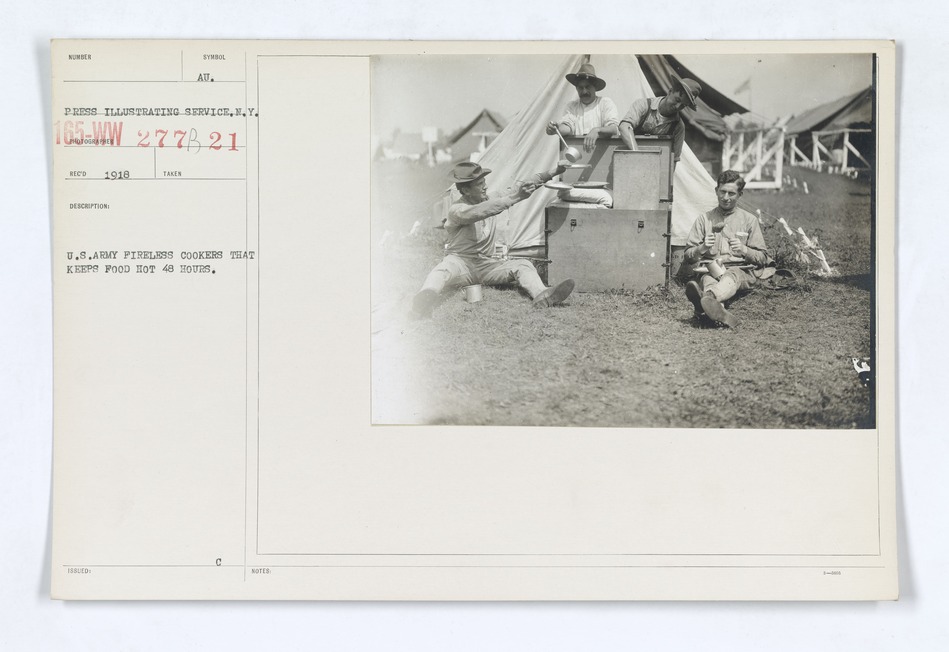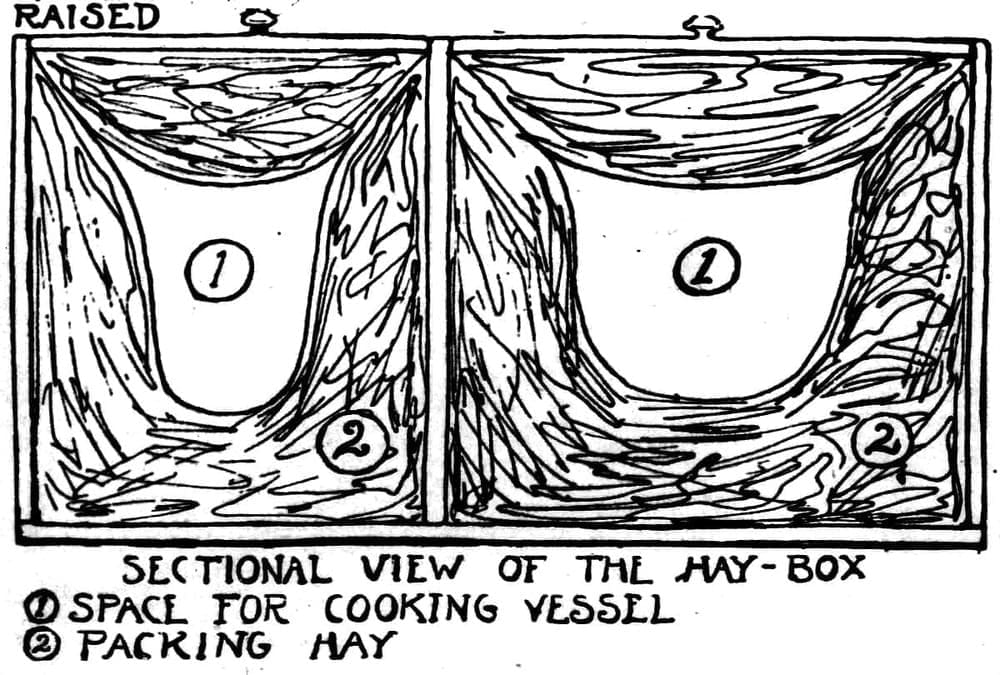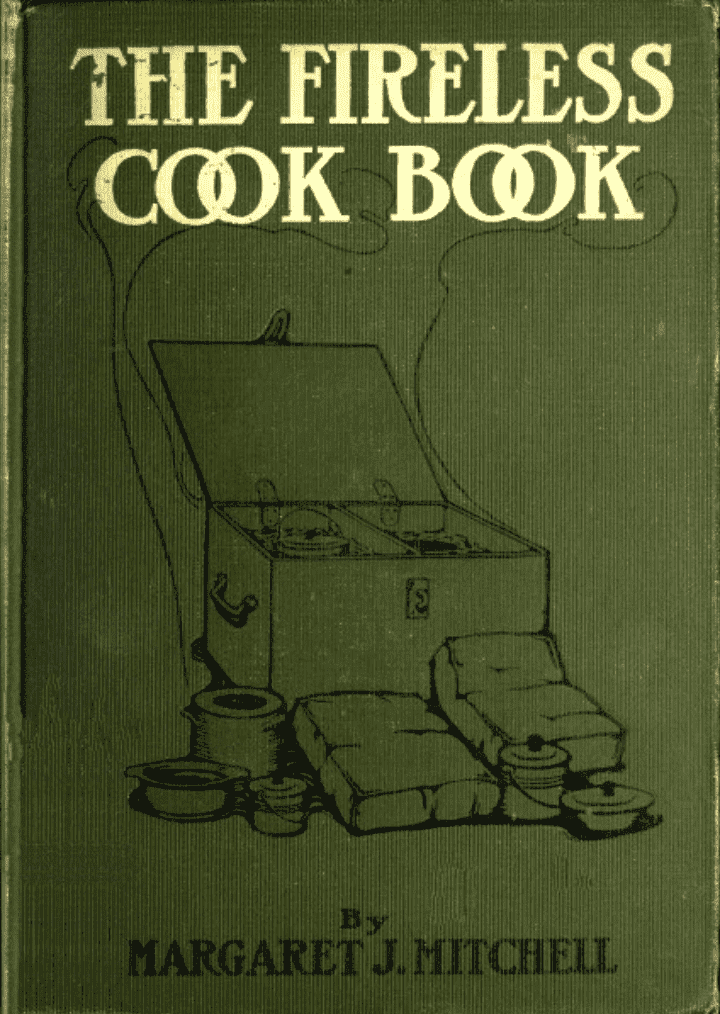How Does a Fireless Cooker Work?
While searching for public domain books to read for free, I came across The Fireless Cook Book: A Manual of the Construction and Use of Appliances for Cooking by Retained Heat, with 250 Recipes.
The fireless cooker is basically a large thermal box.
Despite its name, you still need a heat source to cook, but only to get the water boiling at a high temperature. Once that’s done, the fireless cooker takes over, retaining the heat from the pot to complete the cooking process—without needing external heat or fire. This method can save a lot of fuel, whether you’re using cooking gas or firewood.
I decided to give it a try, and to my surprise, it worked!
Building a fireless cooker is incredibly simple and it can be made with materials you likely already have at home. You can use items like blankets or pillows for insulation and a pot with a tight-fitting lid to help contain the heat even more. The idea is to trap the heat from the boiling food, allowing it to cook slowly over time without needing to consume more fuel.
I did make some modifications to the original design described in the book to avoid materials now know to be carcinogenic.
For example, in the early 1900s, materials like asbestos were often used for insulation, which we now know is carcinogenic. Instead, I replaced it with safer alternatives, such as cotton, plastic or modern insulation materials that don’t pose a health risk. Despite these changes, the basic principle remains the same: retain the heat generated from the initial boil and let it do the rest of the cooking.
This way, a fireless cooker can be a safe and even easier way to save cooking gas.
“Think what it is to have a method of cooking involving no necessity for remaining in the kitchen to keep up a fire or watch the food! As most hay-box cooking takes a considerable length of time, and many articles are not specially injured by overcooking, this means that foods can often be placed in the box and left for hours, while the housekeeper is enabled to go out for a day’s work, or to occupy her time in other ways, with a mind free from all care of the meal that is cooking.”- The Fireless Cook Book, by Margaret Johnes Mitchell
How Long Does It Take to Cook?
I limit the cooking time in a fireless cooker to no more than 4 hours, regardless of the type of food.
The preheating time over the fire (the step before placing the pot in the fireless cooker) varies depending on the food. Some foods, like beans and sorghum, need more time on the fire, while softer foods like rice require less. So, it’s important to take this into consideration.
Once the pot is properly preheated, I leave it in the fireless cooker for 4 hours.
Heat Conservation Efficiency
Once I prepared a meal in a small 2-liter pressure cooker and placed it (at 8 p.m.) into the fireless cooker I’m about to show you how to make.
By 7 a.m. the next morning, the meal was still pleasantly warm, meaning it retained heat for 11 hours. This simple method, using materials you already have at home, allows you to keep food warm for long periods without needing electricity, fire, or reheating.
I think that if I had used a larger pot with more food, the heat retention would have been even higher.
So, a simple homemade fireless cooker is highly effective at preserving warmth even for extended periods.
“The heated vessels containing the food will retain a high temperature for several hours, so that a dinner put into the apparatus at eight o’clock in the morning would be quite hot and ready by five in the afternoon, and would keep hot up to ten or twelve at night, because the felt clothing so completely prevents the escape of the heat; and as the whole is inclosed in a box, there are no currents of air to carry off any other heat by convection.” (“THE SELF-ACTING NORWEGIAN COOKING APPARATUS.” Scientific American 21, no. 11 (1869): 161–161. http://www.jstor.org/stable/26034508.)

How to Make a Fireless Cooker
Container
Find a container that is large enough to hold your pot and the insulating material of your choice (listed in the next step).
I use a plastic plant pot because I already had it on hand, and plastic is a good insulating material.
Insulating Material
Now, you’ll need insulating materials to wrap around the pot inside the container.
Some of these materials include cotton clothes, paper, plastic bags, dry leaves, and others.
I use plastic bags because they’re easy to find and are the most efficient thermal insulator among the options listed above.
Covering the Bottom of the Container
Take some plastic bags and use them to create a thick layer that covers the entire bottom of the container.
Next, lay a thick cloth over the plastic layer you’ve just created.
The cloth is another heat insulator. While it’s a little less effective than plastic, its main purpose here is to prevent direct contact between the hot pot and the plastic bags.
Insert the Pot
Now, prepare your meal as you normally would. Bring the pot to a boil and allow the contents to reach a very high temperature.
Once this is done, turn off the heat source.
If you were to open the pot at this point, you would find that the food is still raw and would remain uncooked even after several hours.
But now it’s time to place the pot inside your fireless cooker to finish the cooking process without using any fire or external heat source!
So, carefully position the pot inside the container, resting it on top of the cloth.
Wrap Around the Pot
Next, take one or two more pieces of cloth and wrap them around the sides and top of the pot, making sure it is completely wrapped.
Then, fill all the empty spaces inside the fireless cooker with more plastic bags, using enough to fill it to the top.
Your fireless cooker is now fully operational!
The heat from the pot and its contents will be trapped in the innermost section of the container, and that heat will then be harnessed to complete the cooking process.

When you open the pot later, you’ll see that your food is fully cooked and hot!
“During ordinary cooking there is a great loss of heat, due to radiation from the cooking utensil and escaping steam. If, however, this heat could be retained, the food would continue to cook in the absence of fire. This is what occurs in the hay-box. Hay, being a poor conductor of heat, will, if closely packed around a kettle of boiling food, maintain, for a number of hours, a sufficiently high temperature to continue the cooking process. The familiar practice of using newspapers or carpet in keeping ice from melting depends upon the same principle. In both cases a material which is a poor conductor of heat, when interposed between the surrounding air and articles which are either colder or hotter than the air, being found to preserve their temperature. Other materials than hay or papers will act in the same way; such, for instance, as excelsior, sawdust, wool, mineral wool, and others.”– The Fireless Cook Book, by Margaret Johnes Mitchell
A Primitive Fireless Cooker
The fireless cooker isn’t a recent invention.
You can use the most “primitive” materials available as insulation material, such as dry leaves.
In fact, hay and straw were the commonly used insulators for the fireless cookers of old.
“Norwegian housewives have known this for many years; and some other European nations have used the hay-box to a considerable extent, although it is only recently that its wonders have become rather widely known and talked about in America. The original box filled with hay has gone through a process of evolution, and become the fireless cooker of varied form and adaptability.”- The Fireless Cook Book, by Margaret Johnes Mitchell
A Modern Fireless Cooker
If you’re looking for something more modern, you can use a large vacuum-insulated container as a fireless cooker.

“A vacuum will have the same effect as insulating materials. The ‘Thermos Bottle’ and similar inventions, which are glass bottles surrounded by a vacuum and contained in metal cases, will keep foods hot or cold for many hours. If heated with a little boiling water before boiling food is poured in they will even cook some foods satisfactorily.”- The Fireless Cook Book, by Margaret Johnes Mitchell
However, I should mention that I haven’t tested it, so I can’t guarantee its effectiveness for fireless cooking.
Other Benefits of Fireless Cooking
It Saves Water
As we allow water to boil for an extended period, it generates an increasing amount of water vapor, causing more water to evaporate from the pot.
Now, if the pot is left on the heat for a brief period, the amount of water lost through evaporation is reduced!
I realized this during my initial experiences with the fireless cooker. After cooking food in the fireless cooker, I opened the pot and noticed that, despite the food being fully cooked, a significant amount of water remained inside the pot.
This happens because the water doesn’t evaporate as much as it would if the pot were left on the fire for a long period of time.
Since then, I’ve started using a smaller amount of water when cooking my meals.
This not only conserves water but also leads to savings in cooking gas, as less fuel is needed to heat a reduced quantity of water.
A More Nutritious Meal
In the typical cooking process, food often loses a significant portion of its nutrients. Moreover, when we subject it to prolonged cooking at extremely high temperatures, the nutrient loss becomes even more pronounced.
Cooking food slowly and gently preserves its nutritional content and flavor and reduces the risk of overcooking or burning.
Therefore, the fireless cooker not only contributes to environmental preservation, cost savings, time efficiency, and reduced effort but also promotes better health.
“The general trend of recent scientific investigation seems to indicate more and more clearly that the prevalent idea that all food must be cooked at a high temperature, such as that of boiling water (212 degrees Fahrenheit), is a mistaken one. Experiments have shown that starches are made thoroughly digestible at temperatures varying from 149 degrees to 185 degrees Fahrenheit. Cellulose, the woody fibre of vegetable foods, becomes perfectly softened at a temperature considerably below 212 degrees, while albuminous materials, of which all animal and many vegetable foods are largely composed, are not only well-cooked at a low temperature, but are decidedly more easily digestible than when cooked at the higher temperatures of boiling or baking.”- The Fireless Cook Book, by Margaret Johnes Mitchell
Recommendations
(1) Make sure the water comes to a full, rolling boil. This is important for eliminating harmful bacteria, viruses, and parasites that may be present in the food, water, and cooking utensils.
You don’t want the presence of these tiny beings in a warm environment for long periods of time.
Bring the water to a full rolling boil for 1 minute (at elevations above 6,500 feet, boil for 3 minutes), as recommended by the Centers for Disease Control and Prevention (CDC).
(2) The high temperature also helps to break down antinutrients commonly found in foods like beans.
(3) I’d also suggest giving the cloths a regular wash and exposing the insulating materials to strong sunlight. This practice can help prevent mold growth.
(4) I personally wouldn’t cook meat, milk or eggs using the fireless cooker. I think it’s too risky not to boil items like that for long periods. Cooking unclean animals would be even worse (and we shouldn’t eat unclean animals).
Thanks for reading! 🙂
Don’t miss the next posts by joining my free email list:
And if you’d like to support my writing (without spending anything), I’d greatly appreciate it!
Until next time, God willing.
Take care!

Leave a Reply